Links have and will be the primary source of ranking factors when it comes to your SEO and organic presence online. How you go about acquiring these links, who you purchase from, how authoritative the pages are which link to you, where your link is placed, the topic behind the article linking to you, and more, all play a factor in whether or not you’re going to beat your competition. For this post, we’re going to be solely focusing on link acquisition and less on the other ranking factors like content length, mobile friendliness, content quality, site speed, secure sites, etc.
It sounds hectic and well, it is when you’re first starting out.
Throughout the years, I’ve worked to refine my strategy of acquiring links to increase the authority of my client’s sites and one of my all-time favorites has always been outreach. The journey to acquire links through outreach is tiresome and will try your wits but the value makes this strategy well-worth the investment.
All you’ll need is a few subscriptions to software, this process I’m about to share (for the first time ever), and a will to provide value to the websites you’re reaching out to. Remember, we’re reaching out to real sites, with real traffic, to real people. Think of each opportunity as a person you would meet face-to-face and you’ll have a good time.
In addition to acquiring links, I’ve found outreach helps build:
1) New Business Relationships – you’re likely going to be reaching out to niche related sites which have a common audience and professional contacts. When done correctly, outreach can help bridge some of these new-found friendships into opportunities later down the road.
2) Friendships – there’s likely thousands and thousands of marketers just like you and me performing outreach on a daily basis. Not every opportunity needs to come directly from your efforts, sometimes the leveraged use of your contacts or approved guest post opportunities for someone else to utilize is enough to have your foot in the door.
3) Sales – On occasion, we’ve perked interest from our own outreach that has turned into new business. I guess they liked our persistent follow-ups and traffic from our promotional techniques.
Alright, this will probably be a lengthy post but I will try and keep the examples shortened, so grab your coffee and let’s dive in.
Identifying Possible Niche Sites
The first step I start with when identifying possible niche sites is simply to refer to my keyword research, after all, we do spend close to 8 hours completing these beasts and we end up saving quite a bit of time during this phase. For the sake of this post, we’re going to be working within the auto, outdoors, camping, and RV niche.
Take for example, this site – www.freedomrvusa.com.
By visiting the web page, you can clearly see that this business focuses on selling RVs, towaways, campers, and parts. All relating to the auto niche and clearly is representable within the above niches I mentioned. This won’t always be this easy when identifying potential targets, if you’re having difficulty or work within a micro-niche, feel free to reach out.
Building a Keyword List
We choose SEMRush for quite a substantial portion of our keyword research (more on this later.) It’s an all around great tool for researching new content ideas, finding keyword search volumes (search volume is not always exact and should be taken with a grain of salt), and much more. While it might be a nice tool to gather ideas around keyword research, the data will likely not provide very useful in building footprints for every occasion.
Below I’ve opened up a search on RV’s in hops of finding some relative keywords to target within our footprints.

Although SEMRush is great for the swiftness that it provides when looking to gather some keyword research but unfortunately is very surface level when it comes to selecting opportunities. Using this tool alone might cut it within a broad niche but I would say in most cases, you’re going to need to pair up with other strategies as well to find the best results.
We’re going to try a bit of brainstorming for this RV niche, since the majority of the keywords within the list above in SEMRush are coming back as thin footprints which I’ll explain more thoroughly below.
Whenever I’m having difficulty finding relevant targets for keywords, I try to break down the niche that I’m in. To do that, you’ll want to ask yourself questions like “what application does this product or service have?” or “in what niche does this product also serve?” or maybe “what do people use this product for? where do they go? what do they want?” etc.
For the RV niche, with my general knowledge within the field, we know that RV’s are used for camping, traveling in comfort/style, and outdoor activities. So what are some keywords that pertain to these aspects?
1) Travel – we can look for specific locations where traveling with an RV has been blogged about. Think geographically, what are some hot spots where families and friends enjoy taking their RV? By doing a quick search, I’ve found a list of the top 10 best RV destinations that we may search for. Some of these options included are; Zion River Resort, Yellowstone National Park, and Redwood National Park.
Upon searching Zion River Resort, I’m getting about 376 results where the URL has a blog, and within the title, they’ve mentioned Zion River Resort. After combing through these 74 results (74 after removing duplicate domains), I’ve found that 48 of them have acceptable traffic.
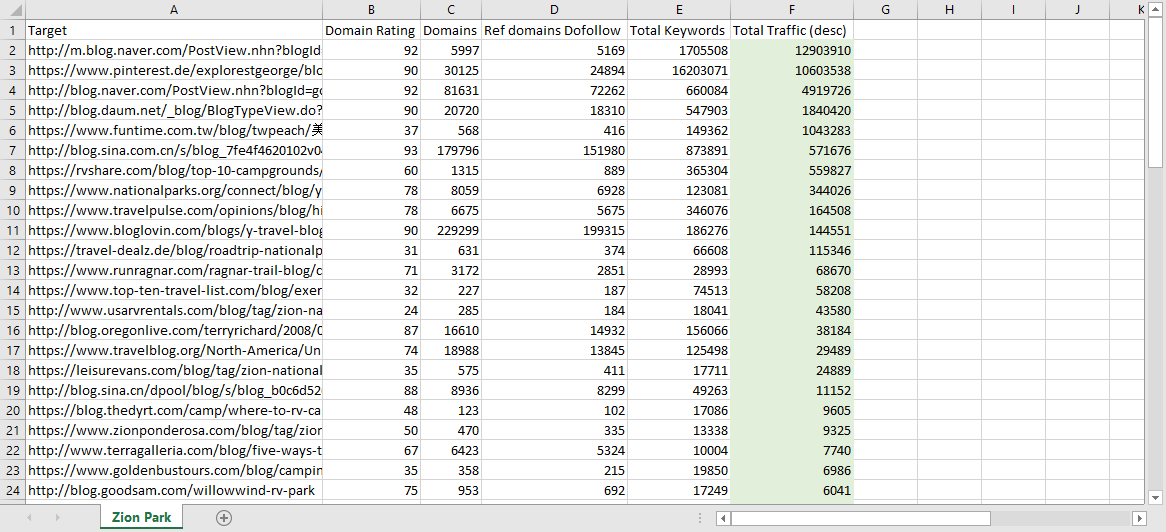
For traffic values, depending on the campaign, I tend to be pretty lenient and go for everything over 100 visitors/month coming from organic searches. For the best results, I’d recommend starting at 1,000 + organic visitors per month.
2) The next stage and questions to this brainstorm is just build off the latter point. Activities such as fishing, camping, hiking, kayaking, etc. will all be possible areas of interest to find potential outreach opportunities. Important to note, application of point #1 will also apply to each of these activities as there are fishing locations, camping locations, and other outdoor activity locations all around the world.
3) Another area we might want to target is to find influencers who have travel blogs and utilize their travel destinations as potential footprints we may build to gather more potential prospects. Maybe we reach out to these influencers and request a resource link or an honorable mention within an existing blog post. You see, these ideas quickly develop into other opportunities that we may not have otherwise though of during our initial strategy for the campaign.
Getting started is all that you need to do and follow the trail of ideas that occur while you’re performing your research prior to beginning your outreach campaign.
Building Footprints
Footprints are essentially the search operators which specifically sort results available to you within search. For example, some of my favorites for identifying specific information is to use something like inurl:blog + intitle:outreach. If you perform this footprint in Google search versus just typing in “outreach”, you’ll find the results are staggeringly different and more targeted to what we’re actually looking for if our intent was to find out more information on SEO outreach rather than sales automation.
Utilizing operators to identify niche sites has been and probably will be my favorite technique solely for the amount of time saved, and how accurately close I can scrape thousands of websites within my niche to prepare for outreach.
In this specific outreach strategy I’m going to share with you, we’re going to focus on one technique and I’ll likely elaborate later to keep this page up-to-date with the best technique I have.
My go-to footprints right now for resource link building and guest posting are as follows which are combination of inurl:, intext:, intitle:, and “keyword” based searches. Try mixing up a combination of these and seeing what works best for your keyword list.
1) inurl:blog + intitle:keyword
2) inurl:blog + keyword
3) inurl:blog + intext:”resources”
4) inurl:keyword + resources
I try to stay away from any of the generic footprints like:
Submit * post keyword or anything that involves being a sponsored/paid post. If it’s not already happening, I predict Google will easily identify posts which are paid or sponsored from those mentioned organically or links mentioned organically within posts. I just feel it looks more suspicious when every guest post out there has a huge label displaying you’ve paid for that position or column feature.
Side note, if you’re the type to run influencer marketing, a simple way to identify these sites using this scraping method I’m about to show you is to use these operators:
1) “k followers” site:instagram.com keyword
Be creative with the variations, you’ll have to sort through these as you would before reaching out to any website for outreach.
Testing Footprints
Once you’ve compiled all your footprints, now comes the time to test them. If you’re going to be testing fewer than 10 or 20 footprints at a time, you’re fine just using your browser without any additional help from a proxy or third-party program. If you prefer a more thorough route and built 100’s of footprints, you’re going to want to outsource this part to your VA or use some in-house program to check for you.
Basically, you’re going to want to plug each of these footprints into Google and record the number of search results yield for each opportunity.
If the results are below 1,000, your footprint is fairly narrow and will need to be combed through to check for relevancy. If your footprint is over a few million than you’re likely going too broad. To reduce the number of results, try going for more specific keywords within your footprints or finding keywords which are less generic within your target industry. On the contrary, if your results are too low, you’ll need to go more generic or perhaps think about utilizing shoulder niche’s outside your exact market but stay relative.
Knowing your niche well is going to come in handy here. I personally like to browse through page by page of results in each footprint to record where the results stop becoming relevant. Later on, having this figure, I know exactly how many results to scrape. If I stop down half way on page 30 with 10 results shown per page, I know that footprint is great to yield 305 results. This strategy works well for footprints over 1,000 results and results may vary for anything less than that.
Here is what my excel sheet currently looks like if you’d like to compare: (minus the recording of relevant results for the time sake)
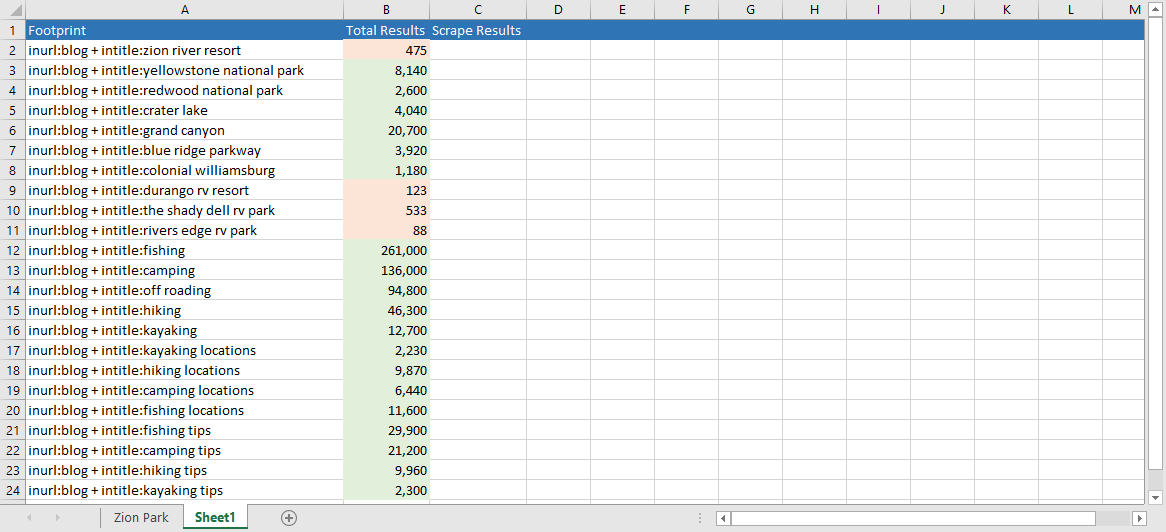
Scrapebox
This tool is the perfect asset to any SEO’s toolbox and for many reasons. With over 30 free additional addons that allow you to do anything from mass shorten URLs to mass grabbing Google images by footprint or keyword, this is something you’re going to want to snatch up if you haven’t already. There’s plenty of helpful tutorial videos online and the community is very supportive towards using this product. Unfortunately, I won’t be receiving any commissions for purchases but I have to admit, I’m a raving fan.
Within this tutorial, we’re only going to be focusing on a few specific areas which we’ll cover below.
Keywords and Custom Footprints

This white box is where you’re going to enter line by line each footprint that you have approved. For best results and to make this process as quick as possible, I recommend grouping your footprints by the numerical value of relevance. For example, if you have 15 footprints each with around 300 relevant search results, plug each of those in here first and scrape by 300.
If you’re not worried about shaving a few minutes off the total completion of this task, scraping one by one should work just fine. After all, when you achieve between 10% and 20% response rates from these cold emails, having a few thousand is going to be plenty depending on the capacity of your ability to fulfill these engagements and how aggressive you want to be with your outreach campaigns.
This strategy works well if all your footprints are directly related or are very close variants of one another.
If you’re planning on creating more than one process and outreach cadence sequence, you’re going to want to segment these lists. For example, if you’re a roofing company, maybe focus one list on just roofing related queries and the other on home improvement. The same would go for every other shoulder niche list.
Proxies
Proxies are going to be the lifeline of your Scrapebox experience and a mandatory addition to any scraping campaign. Utilizing proxies properly will prevent bans and annoying captchas while scraping 100’s or 1000’s of results off Google.
There’s really not much else to be said but here is my go-to provider for proxies. Great customer service and replace proxies quickly whenever I need.
Identifying Outreach Candidates
There’s a few techniques I’m about to show you which easily find the right contact information you need to reach out to a prospective website to inquire about your link opportunities. For this strategy, since we’ve focused on building footprints around websites that contain blogs, we’re going to want to find position titles labeled as one of the following:
1) Copywriter
2) Content Writer
3) Editor
4) Author
5) Content Specialist
If you can’t find any of the above positions for the prospect, I generally reach into item #6 there after.
6) Marketing Manager, Director, SEO, etc.
You get the picture, we want to be focusing on these types of positions because they’re more than likely responsible for curating the content for the prospects blog. This isn’t always the case but I’ve found higher success rates focusing on these job titles.
Here’s an example of a recent job I fulfilled within the home improvement and roofing niche using the following footprint to scrape results:
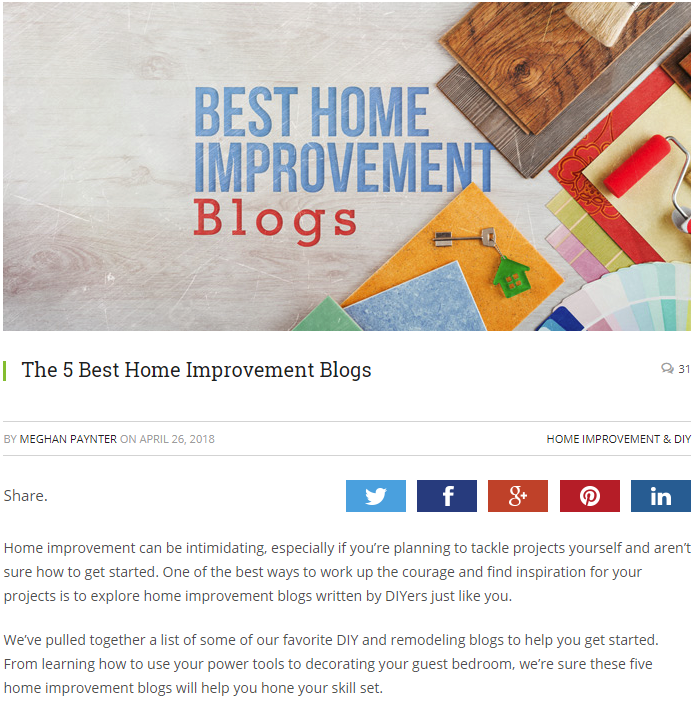
Notice how at the top of this screenshot, we have a “By Meghan Paynter” byline? These subtle bylines are complete gold and can even be focused by building certain types of footprints. Now that you have the name of the last contributor to the blog, the likelihood that this blog will publish another content article from this author or the chance that this author would add an additional resource link back to your website is greater than ever.
Remember, the better the content piece you’re promoting, the easier time you’re going to have earning links by outreach to it. Bloggers, authors, editors, etc. have caught on to the regular antics of outreach and likely receive hundreds of emails per day so differentiating yourself as much as possible from the crowd is crucial.
I’ll likely create a guide on how to find these prospects information in a future post to link here.
Once you’ve compiled your list of prospects, it’ll look something like this, this example is a list within the in-home senior care niche I was prospecting for.
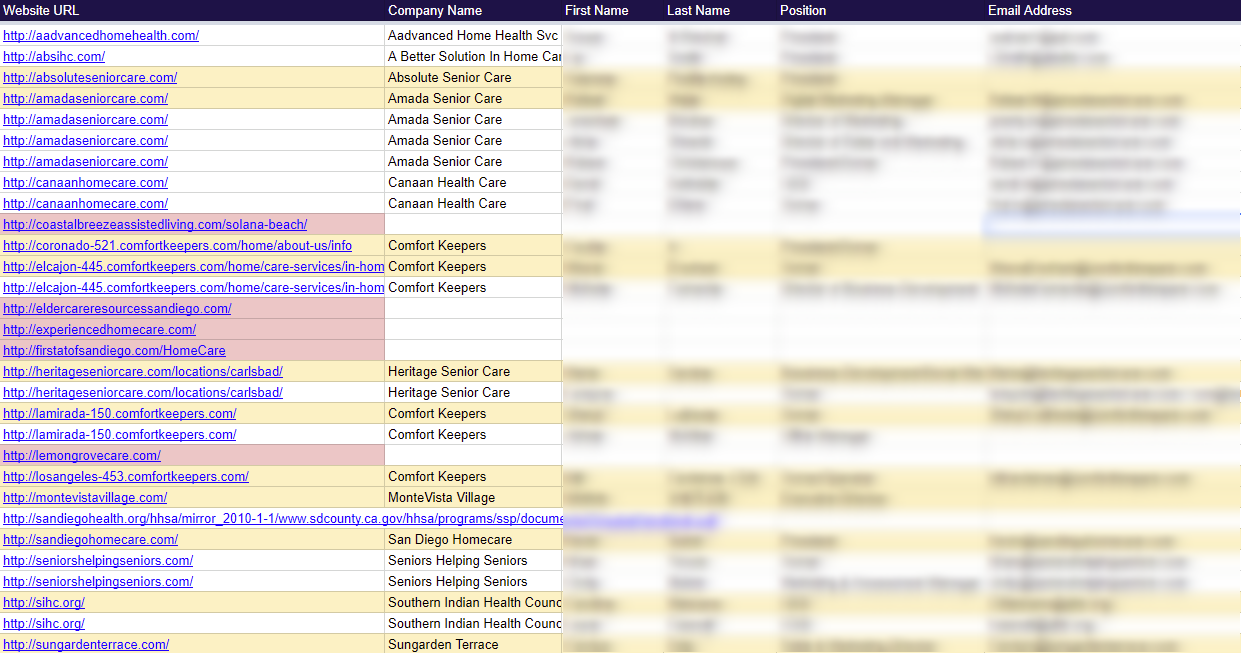
Crafting Email Cadences
Like in traditional email marketing, your subject line, and first sentence are crucial elements you’re going to want to perfect in order to achieve a high response rate for your outreach campaign. Most of the time, this will likely be the first time you’ve contacted this person and they’re not going to know who you are. Make every word count.
The trick here is to quickly introduce your attractive character whom you’ll be promoting to write an article for your prospects.
Here’s a screenshot from my Pitchbox account where I obtained a 25% response rate out of 490 prospects.
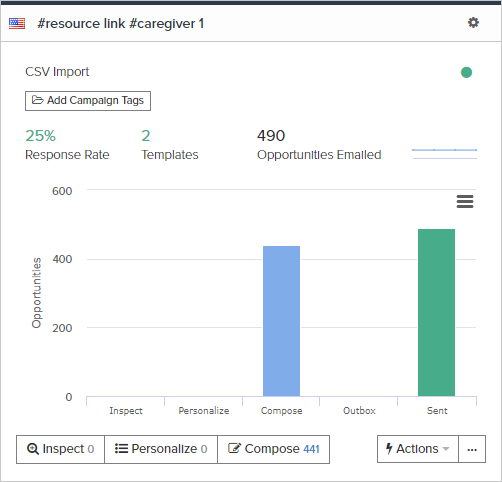
The Subject Line
Finding the perfect subject line is going to be a lot like drop shipping or media buying, trying to find that FOTM product that everyone wants to buy. Just as in Facebook ad creatives, it’s important to test and find the right subject line for your industry or vertical. What may work for some, may not work for others.
Now that that’s been said, I tend to create a persona profile of whom I’m going to be reaching out to and work upwards from there.
Unfortunately, we don’t all get to work in an environment or job opportunity that directly corresponds with our passions or desires but one things certain, the amount of hours we spend invested into these careers, we’re bound to pick up information and knowledge within the field. This is what you’re going to want to leverage within your subject line.
Some strategies that have worked for me in the past are mentioning current events starting as “Hey {[first_name]}, Have You Heard About _.” Keeping subject lines around 65 characters gives you the opportunity to get the point across as to why you might be reaching out while still keeping things short enough to not be cut off by most email clients.
*Important Note* Do not mention back links or purchasing links from the prospect unless they’ve brought it up first. It’s just industry standard and these are real people who have just heard from you, it’s not polite to be so pushy.
The Initial Email Cadence
Think of the first email cadence you send out as an opportunity to introduce yourself to someone within your industry and build your case as to why they’d want to consider receiving a guest post from you or adding resource links pointing back to your site.
This is your chance to build value, add accreditation, and establish authority. After all, they’re much more likely to link to a well-known author, influencer, or key figure within the industry than an SEO who just stepped in to provide outreach for an organization. Find your attractive character, whether that be the Co-Founder of the company you work for, Brand Manager, or someone who’s established within the industry as an expert within your clients organization.
If it’s not in your deck of cards and there isn’t an attractive character within your organization or client’s website, then you’ll need to take a different approach which I will address in another post.
Typically, my first email cadences look something like this:
—
Subject: “{[first_name]}, Have you Heard About {[recent]}?”
Body: Hello {[first_name]},
My name is John Connor and I am the leader of the wordwide human resistance against the machines. I have dedicated my entire life to stopping the mainframe of the machines, Skynet and have earned several awards in the space by my peers as a phenomenal leader. I have also been published in forbes.com, huffingtonpost.com, and entrepreneur.com.
I came across your blog today while generating some ideas for my next blog post in defeating the machines and noticed we write about several similar topics. However, I noticed there wasn’t too much information on {[suggested_blog_post]}, would you like me to contribute an article to ‘fill in the gap’ here on your blog?
With my 20 years of experience within the industry, I’m sure I could conjure up something that our readers would find quite entertaining and informative! Here is our current blog that we’ve been working on for your reference.
johnconnor.com/blog (do not hyperlink)
Let me know what you think and I’ll get you on the schedule ASAP.
Thank you,
John Connor
{[email_signature]}
Let’s have a more detailed look at how I’ve crafted this introductory email cadence.

Highlighted in purple, is the most important aspect of this initial email introduction. This is where you’re going to want to build credibility. This one line “byline” should shape the rest of your cadence. Do your best to point all areas of credibility towards your suggested blog post. The relevancy will take care of itself.
Scrape from anywhere you can to list references of mentions across the web of your attractive character, awards, and the like. Just don’t go too overboard, more than 5 is a little excessive and the receiving prospect is going to get the hint right away.
Be confident but not overzealous.
Showing authoritative websites whom this attractive character has written for in the past will give confidence to our prospect that this content piece we’re offering to contribute will be top quality.
There’s also opportunity here to suggest two or more blog posts, the key here is to show that you’ve done your research on the blog/website and you’re not just suggesting the same topics to the same 100 sites online. Without these personalization fields, I’ve seen my fair share of upset bloggers or editors who will call you out for not doing your due diligence beforehand because you’ve suggested topics that are irrelevant or have been written about 100 times.
Now let’s have a look at the pitch.

I like to put a little elbow grease into my campaigns to show that I’m putting in effort into understanding their content direction, reason behind topic choice, and related content.
As I mentioned before, outreach is not a new strategy of obtaining high-quality links to your site and most links worth obtaining are run by highly experienced editors or authors.
Unless you’re dealing with an over-night affiliate site you’re trying to spam up, retaining your reputation is going to be the number one focus here.
Another thing to keep in mind, the right links have their weight in gold. Obtaining a high volume of low-level links shouldn’t be your priority but earning links on pages that don’t link out often and have a high page authority or powerful links pointing to them should be the goal. These are the links that move the needle.
Within my SOP’s I use this operator to determine what topics or content suggestions I should recommend during my personalization of outreach prospects.
site:yourtargetprospect.com + intitle:yoursuggestedblogtopic
Give it a try yourself on your website, it should look something like this:

In this example, I chose to search for intitle:scrapebox because I figured Moz does not post on this technique for scraping Google results. Upon searching, it’s clear that there were only four related results regarding Scrapebox within the page title and all were coming from community-based questions.
In this case, Google guidelines set aside, offering a detailed guide on how to effectively use Scrapebox might be a good area to suggest for a guest post on Moz within my vertical.
You may also use the operator, site:yourtargetprospect.com + inurl:yoursuggestedblogtopickeyword
Once you’ve found your designated suggested blog topics which haven’t been covered by your prospect and which would provide value to your prospects readers, go ahead and personalize your email cadence to include these topics.
Let’s have a look at the closing segment of our first cadence:
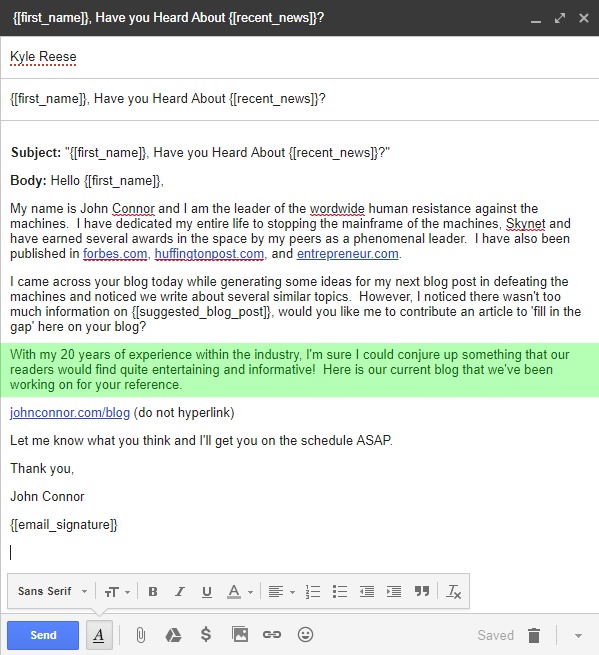
Lastly, within your first outreach email, you’re going to want to reiterate a strong selling point as to why this prospect should trust your attractive character. In this example, I used “20 years of experience.”
It also doesn’t hurt to include some of the recent articles you’ve published either on your blog or guest posted for someone else.
Be sure to include a professional email signature with links to social media, website, a professional photo, and a way to get a hold of you if they have any further questions. Outreach takes a lot of patience and communication back and forth but being persistent and sincere goes a long way.
Spend the most time on your initial cadence as this is going to be used as a reference in your follow-up emails.
Your First Follow-up Email
This may come as a bit of surprise, but I’ve found the most success using very short and simple follow-up cadences for #2, #3, and occasionally #4.
Something like this #2:
—
Subject: {[first_name]}, you there?
Body: Hello {[first-name]},
I was just combing through my notes and noticed I haven’t heard back from you yet, did you receive my last email?
Thanks,
{[email_signature]}
and something like this #3:
—
Subject: Following-up
Body: Hi {[first_name]},
I hope your day is going well, I wanted to reach out once more and see if you had a chance to consider my last email. I know you’re busy and it’ll only take a moment to get this piece started.
Looking forward to your reply,
{[email_signature]}
—
So that’s it as far as email cadences go. Remember, this template and example set I’ve used is just a reference and is meant to be customized and tailored toward your vertical needs. I recommend testing in segments of at least 100 prospects, preferably in the upward 1000’s to gather a sufficient amount of data required to make a decisions as to whether a cadence sequence is working well or not.
Scheduling Email Cadences
Scheduling what time and on what day your emails go out is really one of the few things you can control in the outcomes of your outreach campaigns. Sometimes results may vary and that’s just the luck of the draw.
Here’s my schedule that I typically like to stay on. By observing the campaign setup above, you’ll see that I deploy one introductory cadence followed by 2 to 3 follow-up emails depending on how well the campaign is performing.
If your introductory email is going out on a Thursday at 1:00 p.m. then schedule your follow-ups with a 6 day gap. In doing so, if someone is busier on a Thursday, Wednesday, or Tuesday, it won’t matter. You’re going to reach them on all three.
When your target prospect is in the best mood, is when you should email. Who wants to open a request to guest post at 6:00 a.m. on a Monday morning? People skip breakfast but rarely do they skip lunch.
Responding to Prospects
Be sincere, be polite, and engage in conversation as you would meeting someone in a professional business setting. Everyone you reach out to is likely going to be very busy writing additional content, answering other emails, managing team members, running their business, etc. Be brief and schedule a phone call if the opportunity arises. A 10-minute phone call goes a long way in earning the trust of your potential link prospect.
Sometimes a 5 or 10 minute phone call is the difference of hundreds of dollars when you’re being requested to pay up.
I’ve found it’s best to adopt the mindset of networking rather than building links and unless your content is something like a free custom developed tool that the prospect knows their audience will thrive from, there’s going to be a small amount of negotiation.
Negotiating the Link
When your prospects do ask for a fee, evaluate whether or not that link is worth the amount requested and don’t be afraid to push back. I enjoy utilizing these 10 value building items when negotiating links:
1) Using past guest post examples to share the wins.
2) Reiterate the amount of time your attractive character is going to invest into creating a well-crafted post for your prospects audience and website.
3) If you’re having someone else write for your attractive character, reiterate the monetary amount you’re investing into creating this article for their website. Top-notch articles can reach into the hundreds depending on content length and quality.
4) Evaluate their traffic, websites with higher traffic tend to charge more for link opportunities but this doesn’t always correlate to passed link juice to your website. Know the differences.
5) Evaluate their back link profile, websites like Moz, Ahrefs, SEMRush, Majestic, and others are great at determining a websites page authority where your link will be placed but the best perspective is your own judgement. Websites with links from high authoritative places are generally going to be worth more.
6) Check to see how many other websites this site is linking out to. A gem of a website is one that has high authority and rarely links out. When it does, it links to other authoritative sources. These links are often the most valuable.
7) Opportunity for growth. Do you see this post or other posts on the prospects site gaining links? These tier-2 links (given the links are pointing to a page where your back link is coming from) have their weight in gold, don’t be shy to ask for ideal placements if you’re contributing, especially when you’re paying to play.
8) Reiterate your attention to the post once it goes live. Many of these sites we reach out to have a substantially large email list that they’ll promote their content to. Sometimes consisting of hundreds of thousands of users who’ve trusted their email address with this prospect that we do not want to disappoint. Answering comments, promoting across social media channels, etc. are all important aspects in taking care of your prospect once the post goes live.
9) Utilize testimonials of previous link insertions or guest post opportunities which you’ve done your part in sharing or boosting to your email list or social channels. Prospects love traffic.
10) Offer something of value. A prospect may be working on a task or project that you may already have completed in the past and could prosper from your field of expertise.
Summary
In conclusion, your best bet for finding footprints for great outreach prospects comes down to your ability to wander in the right direction while brain storming ideas. If you’re looking for help with your outreach or have become stuck feel free to reach out with any questions below or you may reach me at mbojerski@convert4.com.
I hope you enjoyed the guide and I’m looking forward to seeing you in the next post!
-Mat
